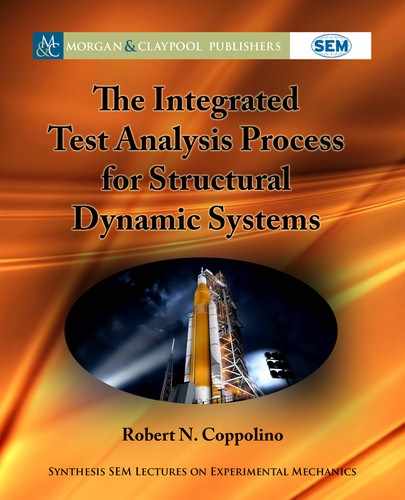126 7. RECONCILIATION OF FINITE ELEMENT MODELS AND MODAL TEST DATA
k
'
m
'
D
Œ
0
; (7.13)
where the generalized residual mass and stiffness matrices are
k
D
‰
T
K
O
‰
;
m
D
‰
T
M
O
‰
: (7.14)
e augmented trial vector set (replacing the reduction transformation of Equation (7.5))
is
N
ˆ
OL
D
ˆ
OL
ˆ
; (7.15)
ˆ
D
‰
'
: (7.16)
When structural alterations are localized, relatively few residual vectors adequately de-
scribe the content of changed system mode shapes. e previously described innovation loses
its appeal when structural alterations are well-dispersed requiring utilization of many residual
vectors.
7.1.4 RESIDUAL MODE AUGMENTATION (RMA) FOR DISPERSED
ALTERATIONS
Definition of residual vectors associated with dispersed, independent alterations of a baseline
structure, described by Equation (7.1), is accomplished by first computing the lowest-frequency
mode shapes of the baseline structure (Equation (7.5)) as well as the lowest mode shapes asso-
ciated with each independent alteration of the structure
Œ
K
O
C Np
i
K
i
Œ
ˆ
iL
Œ
M
O
C Np
i
M
i
Œ
ˆ
iL
Œ
iL
D
Œ
0
.for i D 1; : : :; N /: (7.17)
e selected value of each independent scaling parameter is sufficiently large to produce
a substantial change in mode shapes (with respect to the baseline structure). An initial set of
trial vectors that adequately (and perhaps redundantly) encompass all potential (low frequency)
altered system mode shapes is
Œ
‰
D
ˆ
1L
ˆ
2L
::: ˆ
NL
: (7.18)
is set of trial vectors is expressible as the sum of (a) a linear combination of baseline
system mode shapes and (b) trial vectors (that are linearly independent of the baseline system
mode shapes)
Œ
‰
D
Œ
ˆ
OL
Œ
COR
C
‰
0
: (7.19)

7.1. PART 1: FINITE ELEMENT MODEL MODAL SENSITIVITY 127
e cross-orthogonality coefficient matrix is determined based on the following least-
squares solution:
ˆ
T
OL
M
O
‰
D
ˆ
T
OL
M
O
ˆ
OL
Œ
COR
C
ˆ
T
OL
M
O
‰
0
D
Œ
I
OL
Œ
COR
C
Œ
0
; (7.20)
where
Œ
COR
D
ˆ
T
OL
Œ
M
O
Œ
‰
; (7.21)
‰
0
D
I
OL
ˆ
OL
ˆ
T
OL
M
O
Œ
‰
: (7.22)
e “purified” trial vector set is linearly independent of the baseline system mode shapes
in a manner similar to MacNeal’s residual vectors, as follows:
h
‰
0
T
M
O
ˆ
OL
i
D
‰
T
I
OL
M
O
ˆ
OL
ˆ
T
OL
Œ
M
O
ˆ
OL
D
‰
T
M
O
ˆ
OL
M
O
ˆ
OL
ˆ
T
OL
M
O
ˆ
OL
Œ
0
(7.23)
h
‰
0
T
K
O
ˆ
OL
i
D
‰
T
I
OL
M
O
ˆ
OL
ˆ
T
OL
Œ
K
O
ˆ
OL
D
‰
T
Œ
K
O
ˆ
OL
M
O
ˆ
OL
OL
Œ
0
: (7.24)
While the “purified” trial vector set has the above property, it includes an unnecessarily
large number of vectors. An appropriate, substantially smaller set of residual vectors is identified
by singular value decomposition of the generalized mass matrix,
Œ
A
D
‰
0T
M
O
‰
0
: (7.25)
e singular value decomposition process involves solution of the eigenvalue problem,
Œ
A
'
D
'
;
1
2
3
: : : : (7.26)
e cut-off criterion, noted below employed to define suitable reduced trial vector set, is
N
1
tol D 10
N
(where N 4–6 is usually adequate): (7.27)
e augmented trial vector set (replacing the reduction transformation of Equation (7.5))
is
N
ˆ
OL
D
ˆ
OL
‰
0
'
: (7.28)
e form of the resulting Ritz, multi-parameter sensitivity model (for selected values of
the scaling parameters) is
..................Content has been hidden....................
You can't read the all page of ebook, please click here login for view all page.
